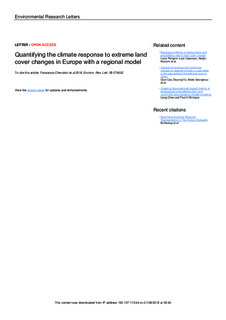| dc.contributor.author | Cherubini, Francesco | |
| dc.contributor.author | Huang, Bo | |
| dc.contributor.author | Hu, Xiangping | |
| dc.contributor.author | Toelle, Merja | |
| dc.contributor.author | Strømman, Anders Hammer | |
| dc.date.accessioned | 2018-09-05T11:03:54Z | |
| dc.date.available | 2018-09-05T11:03:54Z | |
| dc.date.created | 2018-05-29T10:13:51Z | |
| dc.date.issued | 2018 | |
| dc.identifier.citation | Environmental Research Letters. 2018, 13 (7), . | nb_NO |
| dc.identifier.issn | 1748-9326 | |
| dc.identifier.uri | http://hdl.handle.net/11250/2560922 | |
| dc.description.abstract | Many future scenarios expect a key role for the land use sector to stabilize temperature rise to 2 °C or less. Changes in land cover can influence the climate system, and the extent and magnitude of the anthropogenic modifications at local and regional scales is still largely unexplored. In this study, we use the regional climate model COSMO-CLM v.4.8 to quantify the climate response to idealized extreme land cover changes in Europe. We simulate four idealized land use transitions involving abrupt conversion of today forestland to bare land or herbaceous vegetation, and conversion of today cropland to evergreen needle-leaf forest or deciduous broad-leaf forest. We find that deforestation to bare land and herbaceous vegetation causes an annual mean regional cooling of −0.06 ± 0.09 (mean ± standard deviation) and −0.13 ± 0.08, respectively. Afforestation to needle-leaf and broad-leaf forests leads to a mean warming of 0.15 ± 0.09 °C and 0.13 ± 0.09 °C, respectively. Precipitation declines after forest clearance and increases with afforestation, but the spatial variability is high. Temperature impacts are usually more significant in the grid cells affected by land cover change and show a clear latitudinal pattern and seasonal variability. The mean temperature response to deforestation turns from positive to negative between 50 and 55° latitude, and shows the strongest cooling in spring (>2 °C, high latitudes) but warming in summer (>1 °C), when the average number of hot days is increased. Afforestation has the major average warming impacts in winter, where the frequency of cold temperature extremes is reduced. Overall, biophysical effects from land cover changes shape European climate in different ways, and further developments can ultimately assist decision makers to modulate land management strategies at different scales in light of climate change mitigation and adaptation. | nb_NO |
| dc.language.iso | eng | nb_NO |
| dc.publisher | IOP Publishing | nb_NO |
| dc.rights | Navngivelse 4.0 Internasjonal | * |
| dc.rights.uri | http://creativecommons.org/licenses/by/4.0/deed.no | * |
| dc.title | Quantifying the climate response to extreme land cover changes in Europe with a regional model | nb_NO |
| dc.type | Journal article | nb_NO |
| dc.type | Peer reviewed | nb_NO |
| dc.description.version | publishedVersion | nb_NO |
| dc.source.pagenumber | 12 | nb_NO |
| dc.source.volume | 13 | nb_NO |
| dc.source.journal | Environmental Research Letters | nb_NO |
| dc.source.issue | 7 | nb_NO |
| dc.identifier.doi | 10.1088/1748-9326/aac794 | |
| dc.identifier.cristin | 1587335 | |
| dc.relation.project | Norges forskningsråd: 244074 | nb_NO |
| dc.relation.project | Norges forskningsråd: 254966 | nb_NO |
| dc.description.localcode | © 2018 The Author(s). Published by IOP Publishing Ltd. Original content from this work may be used under the terms of the Creative Commons Attribution 3.0 licence. | nb_NO |
| cristin.unitcode | 194,64,25,0 | |
| cristin.unitname | Institutt for energi- og prosessteknikk | |
| cristin.ispublished | true | |
| cristin.fulltext | original | |
| cristin.qualitycode | 1 | |

